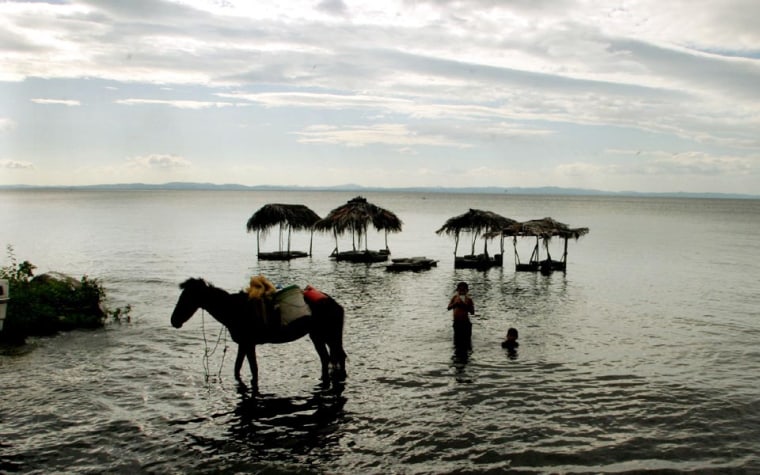Lots of people have heard about Nicaragua—trouble is, the name was most recently associated with fighting and guns. The shooting ended long ago, but a new kind of fame may be starting: Drawn to the same ecosystem that has made its southern neighbor, Costa Rica, a tourism hot spot, people are visiting Nicaragua in skyrocketing numbers. In the first three months of this year, more than 30,000 Americans came—that’s up 26 percent from the same period in 2003.
Travelers land in Managua (TACA flies from the States), in the middle west of a country about the size of Greece. An earthquake flattened Managua in 1972 and the city is still rebuilding; there’s more fun to be had elsewhere. Hotel Europeo, with A/C and a pool, is affordable for stopovers.
With a history of conflict dating from 16th-century conquistadors to the Sandinistas of the 1970s, León, 50 miles northwest of Managua, has a dozen 18th-century churches and a lively university scene. Buses make regular 30-minute runs southeast to the excavated ruins of Old León, a UNESCO World Heritage Site. In 1526, the explorer Córdoba was decapitated in the main square; four years ago his remains were discovered and placed in a new on-site tomb.
Matagalpa, two hours north of Managua by bus, is the heart of Nicaragua’s coffee country. Just outside of town, Selva Negra (“black forest”) is a chalet-style lodge set in dense woods where clouds frequently roll in, creating atmospheric alpine fog. The property’s trees are home to sloths, toucans, and long-tailed birds called quetzals. In the morning, guests wake up to the deep-throated roars of howler monkeys.
The country’s southwestern region is dominated by Lake Nicaragua, which is roughly the size of Puerto Rico. The old waterfront port of Granada, 30 miles southeast of Managua, feels as if it were transported from classic Europe, with pillared stone buildings lining cobblestone squares. Hotel Alhambra’s patio restaurant overlooks the Parque Central’s giant shade trees. At sunset, boats cruise for about $15 an hour from Granada’s quay through Las Isletas, an island chain that crawls with birds and monkeys. A few nearby villages run handicrafts markets; the one located in Masaya specializes in hammocks (a typical price is $35).
Rising above western Lake Nicaragua, dumbbell-shaped Ometepe island comprises twin volcanoes, one extinct (Volcán Madera), and one active (Volcán Concepción, which last erupted in 1957). Boats to Ometepe leave from Granada. Villa Paraíso, a simple hotel near the ferry landing, makes a central base for exploring the volcanoes. It also rents horses, with a guide, for just $5 a day. A short bus ride away from Villa Paraíso is La Finca Magdalena, a coffee plantation with a trailhead for climbing to the turquoise lake atop Volcán Madera. The four-hour hike passes petroglyphs left 1,700 years ago by the Náhuatl people.
Like Costa Rica, Nicaragua has both Pacific and Caribbean coasts. San Juan del Sur, the west coast’s premier beach town, was once a simple fishing village, but expats from the States, Europe, and Australia, seduced by the laid-back lifestyle, have built hillside villas. Holland America cruise ships have also started calling. Beds are easy to find in the town’s many hospe-dajes—often simply converted houses—for $4 to $15. The relatively upscale Piedras y Olas hotel overlooks the bay.
The east coast beach scene is more rustic. The Corn Islands, 45 miles off the mainland (flights leave from Managua on La Costeña airlines for $119 round trip), were once pirate haunts; wrecks lie in shallow, clear water, inviting scuba divers. On Big Corn and Little Corn Islands, seven miles apart, lobster dinners are less than $10 at the seaside restaurants that dot the shores. Casa Iguana, an inn on Little Corn (which takes up just one square mile), is American owned, secluded, and built on a cliff over the water. Ferries depart from Big Corn’s Brig Bay for $5.
Nicaragua
Lodging
- Hotel Europeo 75 meters west of Canal 2, Residencial Bolonia, Managua, 011-505/268-2130, hoteleuropeo.com.ni, $34–$49
- Selva Negra Kilometer 140, Matagalpa-Jinotega Hwy., 011-505/612-3883, selvanegra.com, $10–$150
- Hotel Alhambra Parque Central, Granada, 011-505/552-4486, $50–$75
- Villa Paraíso Santo Domingo Beach, Ometepe, 011-505/453-4675, ibw.com.ni/u/vparaiso, doubles $18
- Piedras y Olas 1 block east of La Parróquia church, San Juan del Sur, 011-505/458-2110, piedrasyolas.com, $90–$135
- Casa Iguana Near Iguana Beach, Little Corn Island, no phone, casaiguana.net, $25–$80
Attractions
- Old León 20 miles southeast of León on Lake Managua, 8 a.m. to 5 p.m. daily, $1
Transportation
- TACA 800/400-8222, taca.com, round-trip L.A.–Managua around $550
- Boats to Ometepe Port of Granada, 011-505/552-4313, Mondays and Wednesdays, three hours $2.50
- La Costeña 011-505/263-1228, centralamerica.com/nicaragua/tran/costena.htm
